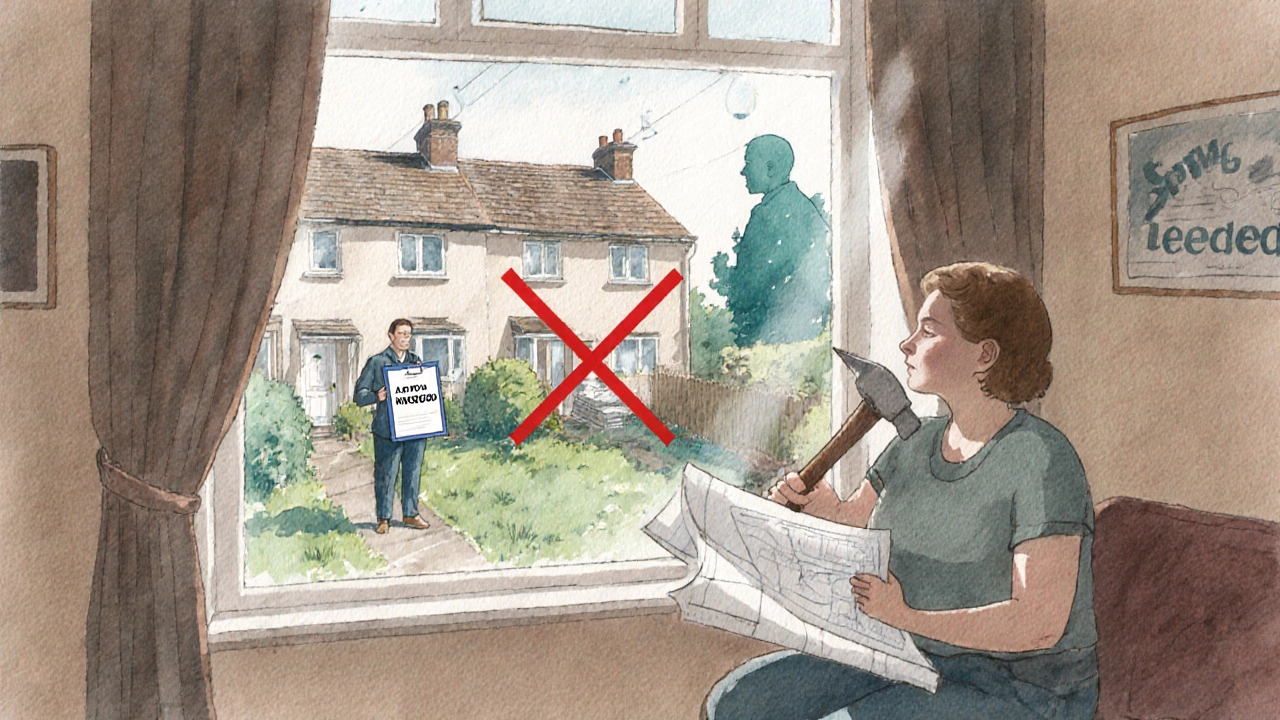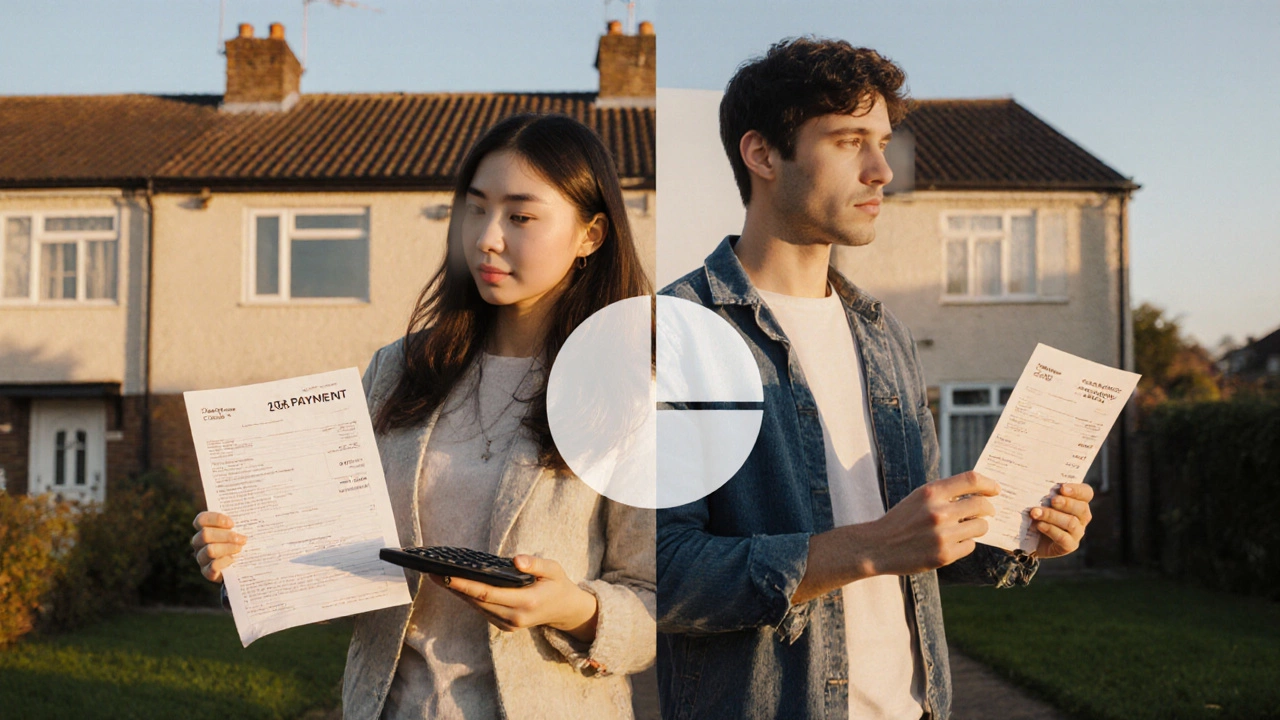Shared Ownership Cost Calculator
Calculate Your Shared Ownership Costs
Compare your monthly payments for shared ownership versus a traditional mortgage
Compared to a full mortgage: Your monthly payment is similar to a full mortgage.
When you hear about Shared ownership is a housing scheme that lets you buy a portion of a property-usually between 25% and 75%-while paying rent on the remaining share. It sounds like a win‑win for many first‑time buyers, but the reality comes with a few hidden roadblocks. Below we unpack the three biggest shared ownership disadvantages you’ll face, backed by real‑world numbers and practical tips to keep the stress down.
1. You Still Pay Rent on Top of a Mortgage
One of the most common misconceptions is that buying a share eliminates rent entirely. In fact, you’ll have a mortgage on the portion you own and a rental bill on the rest. This double‑payment can squeeze cash flow, especially if interest rates climb.
- Mortgage part: If you own 50% of a $300,000 home, you’ll finance $150,000. At a 5% rate, that’s about $805 per month.
- Rent part: The remaining 50% is rented out by the housing association, often at a discounted rate (usually around 2.5% of the full property value). Using the same $300,000 example, that’s roughly $625 per month.
Combined, you’re paying about $1,430 each month-often higher than a conventional mortgage for the full value. If your income fluctuates, this can become a major budgeting headache.
Mortgage is a loan specifically used to purchase real estate, typically repaid over 25‑30 years with interest payments that can rise if you’re on a variable rate. Meanwhile, the Rent you owe to the housing association that still owns the unsold share of the property is subject to periodic reviews, meaning your total monthly outgo can jump without warning.
2. Limited Flexibility and Resale Constraints
Shared ownership homes sit on a leasehold structure, which brings a set of rules that can limit what you can do with the property.
Leasehold is a type of property ownership where you own the right to occupy the land or building for a fixed period, often 99 or 125 years. Because you don’t own the land outright, you need the freeholder’s (usually the housing association’s) approval for major alterations, sub‑letting, or even putting up satellite dishes.
When you decide to sell, you can only sell the share you own, and you must first offer it to the housing association-often at a price they set based on market valuation. This “right of first refusal” can delay the sale and sometimes lower the final price you receive.
Another practical snag: because the market for shared ownership shares is smaller, you might find fewer interested buyers, leading to longer time on the market and potentially accepting a lower offer.
3. Complex Staircasing and Rising Service Charges
Staircasing-buying additional shares to increase your ownership stake-sounds simple, but the process can be pricey and administratively heavy.
Staircasing is a stepwise purchase of additional equity in a shared‑ownership property, allowing the buyer to own a larger percentage over time. Each time you stair‑case, you pay the current market price for the new share plus legal fees, valuation costs, and sometimes a stair‑casing premium (often 5‑10% of the added value). If property prices have risen since your initial purchase, the cost can be substantial.
On top of that, many shared‑ownership homes carry Service charges that cover building maintenance, insurance, and communal area upkeep. These fees are not fixed; they can increase each year, especially in older developments where major repairs (e.g., roof replacement) are imminent.
Combined, staircasing costs and rising service charges can erode the very affordability that attracted you to the scheme in the first place.

Quick Checklist: Red Flags to Watch
- Do the combined mortgage + rent payments exceed 30% of your net income?
- Are the lease terms restrictive for the changes you plan (e.g., home office, extensions)?
- What is the current service charge, and how has it changed in the past three years?
- How much would the next staircasing step cost based on today’s market value?
- Is the housing association’s right‑of‑first‑refusal policy transparent and fair?
Comparison Table: Three Disadvantages Side‑by‑Side
| Disadvantage | Typical Impact | Average Cost (NZ$) | Mitigation Tip |
|---|---|---|---|
| Rent on unsold share | Higher monthly outgo | ~$600‑$800 per month (50% share) | Budget for total housing cost; consider larger initial share |
| Leasehold restrictions | Limited renovation freedom | Variable (approval fees $200‑$500) | Check lease terms before buying; negotiate flexibility |
| Staircasing & service charges | Unexpected large expenses | Staircasing 5‑10% premium + $1,000‑$2,000 fees; service charges $150‑$300/month | Plan staircasing timeline; set aside a reserve fund |
How to Protect Yourself
Even with these disadvantages, many people find shared ownership a viable pathway onto the property ladder. Here’s a short‑term plan to keep risks in check:
- Run the numbers: Use a spreadsheet to add mortgage, rent, service charges, and projected staircasing costs over the next five years. If the total exceeds a comfortable threshold, reassess the share percentage you buy.
- Read the lease carefully: Look for clauses on sub‑letting, alterations, and the housing association’s right of first refusal. Ask a solicitor to flag any “gotchas.”
- Talk to existing owners: Their real‑world experiences with service charge hikes or staircasing can reveal hidden costs before you sign.
- Secure a contingency fund: Set aside at least 10% of the property’s value for unexpected repairs or staircasing premiums.
- Consider future resale: Research how quickly similar shared‑ownership units have sold in your area. Faster turnover usually means fewer price‑drop worries.
Frequently Asked Questions
Can I rent out the part of the house I own?
Usually not. Lease agreements for shared ownership often prohibit sub‑letting without the housing association’s explicit permission, and they may charge a fee for approval.
What happens if property values fall?
Your mortgage may become higher than the market value, but you still owe the same loan amount. Staircasing becomes less attractive, and you might face negative equity if you try to sell.
Do service charges cover council rates?
Generally no. Service charges cover building maintenance and insurance, while council rates are billed separately to each household.
Can I increase my share by more than 10% at once?
Yes, you can purchase any amount up to 100%, but each purchase triggers its own valuation and legal costs. Large jumps can be expensive.
Is shared ownership available everywhere in New Zealand?
The scheme is most common in larger cities like Auckland and Wellington, where housing affordability is a bigger issue. Rural areas have fewer options.
